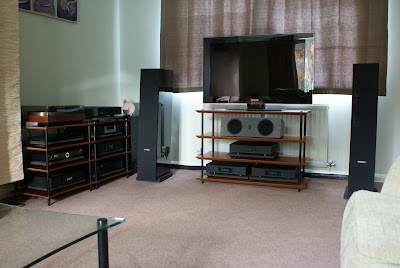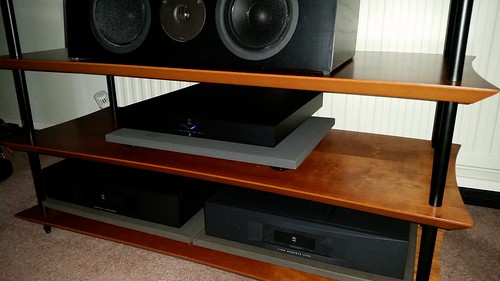This review is as a
result of a visit to this dealer to pick up a demo pair of PMC speakers and is
therefore written as a customer, not as a reviewer as such. Hifi Lounge were not aware that I would be
writing about the visit (in fact, neither did I at the time, it occurred to me
later that it might be something worth writing about).
Are the days of the
high street hifi specialist numbered?
House of Linn is a large Victorian end terrace house in a residential
area of a town just outside the M60 Manchester orbital, Cymbiosis are in
converted farm buildings and there are many other examples. As hifi polarises into mass market
convenience and high priced specialist products, with those companies and
dealers in the mid-range probably feeling increasingly squeezed, there is no
need for the higher end dealers to remain in the high street. “Passing traffic” is no longer likely to just
drop in, rents are very high, customers want somewhere easy and convenient to
park, and most auditioning is based on pre-arranged appointments. Buying quality hifi is now more likely to be
a long decision process that’s best done in comfortable, more home-like
surroundings in a quiet location with none of the distractions and hassles of a
town centre.
Which brings me to
Hifi Lounge, based just outside Bedford.
The approach is along a gently winding country road and a smooth gravel
drive that feeds a number of “units”.
But these are not units of the industrial variety, but converted
brick-built former farm buildings. The
car park is surrounded by trees, well-kept grass and hedges. As soon as I arrived I felt relaxed and I
hadn’t even got through the door. Hifi
Lounge is identified by a discrete logo on one of the buildings and you enter
through a lowish wooden door. Paul
greeted me with a friendly smile and handshake.
He’s an easy bloke to get on with, as is his partner Wendy and it feels
more like going to visit some friends, or perhaps genial B&B hosts, rather
than a retail environment.
On the left is the
“office” area with desk and some stock.
This is also online central for web content and correspondence. Straight ahead is the staircase and on the
right is the smaller dem room and, importantly, the kitchen area. A good mug of proper tea was soon in hand –
appropriately in a PMC branded vessel.
This smaller dem room is arranged with kit along the longer wall and a
sofa opposite, thankfully a good distance away from the wall behind the
listener. A good number of items of kit
are lined up on racks and there are some pairs of speakers – one pair set up
for listening, the others along the shorter end wall. On the day of my visit there was much
evidence of Naim, Rega, Bryston, Arcam and PMC in this room. Whilst being the smaller room (I’m guessing
its about 5m x 4m), it does represent a very realistic size for many homes and
will therefore help a good number of customers get a decent impression of a
realistic set up. Décor is both modern
(with wall art mural), casual and comfortable.
The ceiling is lowish, giving a cosy feel. Nice.
When I was there,
another customer was listening to some amp options in the, much larger,
upstairs dem room. This is slightly
larger in floor area but also enjoys a high vaulted ceiling with exposed
beams. There’s a projector available and
this room will better suit larger speakers, customers with larger rooms and, at
a guess, those with larger wallets too.
I appreciated the 12” picture frames containing album sleeves –
apparently these are changed from time to time and were recently all filled
with Bowie albums as a mark of respect and appreciation. I didn’t spend much time up here as there was
a dem in progress and we didn’t want to disturb the other customer. Back downstairs and Paul and I chat for a
while about music choices, my current system, why PMC, what I was looking for
in terms of a performance upgrade etc.
Paul comes across as genuinely interested, willing to discuss stuff he
doesn’t sell and understand its merits and is clearly enthusiastic about the
location and facilities he has to offer customers.
The PMC speakers are
the demo units, so Paul brings the boxes and we pack them up together, still
chatting about music and hifi. Shortly
afterwards the other customer comes down and joins in the chatter and it seems
we have some work colleagues – current and past - in common. I live in North Wales and have worked in
Scottish, Yorkshire and London locations and here I am discussing colleagues
with a stranger in Bedfordshire. Small
World and all that.
Given that I’ve never
done any business with Hifi Lounge before, I felt very welcome and that Paul
was interested in what I’m looking for.
On top of that, with a refundable deposit sorted, Hifi Lounge were happy
for me to take their pair of Twenty.26 speakers away to North Wales and
audition them for a week in my own system.
Doing anything other than this would’ve been pretty pointless really, using
a different room and electronics from a completely different supplier (ie, in
the shop) would not have provided much information really – certainly no
benefit over my existing experience with the 26s at hifi shows and from
magazine reviews. Hifi Lounge were
positively keen for me to ensure that I got a good long home audition before
spending with them. There was no quibble
or doubt about trusting me with the speakers, even as a stranger – they clearly
understand their customers’ needs and how to support those needs. This is a
great way to engage a customer and gain their trust, as well as their long term
repeat business.
Once the speakers were
loaded up into the car, there was one more thing I wanted to try whilst I was
there. I’d taken my FiiO X3 portable
hi-res FLAC player and my Audioquest Nighthawk headphones along as I wanted to
give the new Chord Mojo DAC / headphone amp an audition, and knew that Hifi
Lounge are Chord dealers. So Wendy took
me over to the headphone room, opened it up, set the lighting ambiance and let
me get on with trying the kit. But
first, what about the room? A very long,
slim room, totally dedicated to the pursuit of high quality sound strapped to
your head. I’m guessing, but the room is
probably around 8m long with all the kit arranged along one wall, with tall
narrow windows down the opposite wall.
The kit wall has a waist high shelf with headphone amps from one end to
the other – above this is an equally long row of high quality headphones on
headphone stands. All the well-reviewed
kit is there – Audioquest, Grado, Oppo, Audez’e, STAX, Audio-Technica,
Sennheiser, Shure, AKG, BeyerDynamic etc. etc.
What an array of choice!
I settled into one of
the sumptuous leather wing backed chairs with the FiiO / Mojo / Nighthawk combo
and lined up some tunes. Wendy left me
to it, just saying I should take my time and come back to the main shop when I
was ready. The first thing that struck
me about the Mojo is how tiny it is.
Somehow, even after reading that it’s about the same size as a pack of
cards, it still came as a surprise that it is, actually, the size of a pack of
cards. I suppose I’m just used to so
much hyperbole in the press these days that I thought this was rhetoric for
effect rather than reality. So there it
is, tiny. But beautifully built – the
satin black anodised aluminium casing feels solid and machined (as opposed to
pressed) – it feels much more expensive than the list price would suggest. The Mojo accepts normal USB and coax SP/DIF
digital inputs, but also those from iPhones and Android – so great for being on
the move. The controls are OK – you soon get used to what long press vs short
press does and the action is solid and “well oiled” so to speak – the only
downside being the rather bright colours which could be distracting in a
darkened room. But once the tunes start
playing this rather pales (sorry!) into insignificance.
I hooked up the FiiO
using the coaxial digital output and set the Mojo to a sensible listening level
– so not too loud. Last time I heard a
Chord DAC / headphone amp was when I bought the Nighthawks – it was the larger
and more expensive Hugo and I wasn’t impressed.
The Hugo receives very good reviews but sounded artificial to me –
certainly the same headphones being powered by the Audioquest Dragonfly and a
Trilogy 931 amp was a much better experience – that combination working well
together to provide a more natural, flowing and musical result. So what of the Mojo? Well it is most definitely a more enjoyable
listen than either of those I tried earlier – there’s oodles of detail, but its
refined not forced, it doesn’t sound like you’re listening to something
digital, in that edgy, gritty excessive brightness that so many low budget
digital products deliver. This is
classy. There’s slam, deep bass and
great timing - the music bounces along with energy but control. This little box of tricks is a
revelation. At the price it’s an absolute
steal. I don’t have one yet, but once
the main system has settled down I’ll be investing, and certainly before some
long flights I’m expecting later in the year (and I’ll go back to Paul and
Wendy to get mine). If you’re as old as
I am then you’ll understand what I mean when I say I think the Mojo is probably
this generation’s equivalent to the NAD 3020 – everyone should have one that’s
looking for top quality listening on a reasonable budget. I’ve heard a lot of headphone amps in the
last 12 months, this is easily the one to beat up to at least £1000. Brilliant.
So Hifi Lounge – great
location, great facilities and a warm welcome from Paul and Wendy. I enjoyed my visit there, which is not
normally something I can say about retail experiences. They’re helpful, friendly, relaxed, clearly
keen to let the customer spend time and make their own decisions, they run
interesting events from time to time and offer great service, even to new
arrivals. Oh, and one of the best
headphone choosing experiences anywhere.
Hifi Lounge have
kindly reviewed this post for factual accuracy, but have had no influence on
the opinions expressed.
























